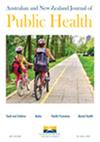澳大利亚悉尼公共卫生限制期间居民的背景社会经济和人口统计学特征对COVID-19结果的影响
IF 2.4
3区 医学
Q2 PUBLIC, ENVIRONMENTAL & OCCUPATIONAL HEALTH
Australian and New Zealand Journal of Public Health
Pub Date : 2025-03-06
DOI:10.1016/j.anzjph.2025.100228
引用次数: 0
摘要
目的探讨居民背景社会经济和人口统计学特征对公共卫生措施期间COVID-19结局的影响。方法采用新南威尔士州应通报条件信息管理系统中与澳大利亚人口普查数据相关联的汇总数据,按严格和宽松措施的时期进行分析。结果在严格防控措施实施期间,社会经济地位较低地区的居民感染风险较高,社会经济地位最低地区的感染风险高于社会经济地位最高地区(风险比(HR) 7.15, 95%可信区间(CI) 6.24 ~ 8.19)。40岁及以上人群感染风险较低,男性较高(HR 1.34, 95% CI 1.27-1.40);居住在家庭规模较大地区的人(HR 1.56, 95% CI 36-1.78);以及在南亚出生的居民占很大比例的地区的个人(HR 1.18;95% CI 1.07-1.29),东南亚(HR 1.20, 95% CI 1.07-1.36)以及中东和北非(HR 1.67, 95% CI 1.47-1.90)。在放宽限制期间,变量的影响减弱,但仍然显著。结论在严格的公共卫生措施下,少数民族、社会经济地位较低地区和家庭人口较多的人群的COVID-19预后较差。对公共卫生的影响决策者应调整服务以避免不公平现象。本文章由计算机程序翻译,如有差异,请以英文原文为准。
The impact of contextual socioeconomic and demographic characteristics of residents on COVID-19 outcomes during public health restrictions in Sydney, Australia
Objective
To investigate the impact of contextual socioeconomic and demographic characteristics of residents on COVID-19 outcomes during public health measures.
Methods
Aggregated data from the NSW Notifiable Conditions Information Management System linked to Australian Census data, by periods of strict and relaxed measures, were used.
Results
During strict measures, residents of areas of lower socioeconomic status (SES) had a higher risk of infection, with the lowest areas having greater risk compared with the highest areas ((hazard ratio (HR)) 7.15, 95% confidence interval (CI) 6.24-8.19). The risk of infection was lower for those aged 40 and over and was higher for males (HR 1.34, 95% CI 1.27-1.40); those in living in areas with larger household sizes (HR 1.56, 95% CI 36-1.78); and individuals in areas with a large proportion of residents born in South Asia (HR 1.18; 95% CI 1.07-1.29), South East Asia (HR 1.20, 95% CI 1.07-1.36) and the Middle East and North Africa (HR 1.67, 95% CI 1.47-1.90). During relaxed restrictions, the impact of variables attenuated but remained significant.
Conclusions
Minorities, those residing in lower SES areas and those living in larger households had worse COVID-19 outcomes during strict public health measures.
Implications for Public Health
Decision-makers should tailor services to avoid inequities.
求助全文
通过发布文献求助,成功后即可免费获取论文全文。
去求助
来源期刊

Australian and New Zealand Journal of Public Health
医学-公共卫生、环境卫生与职业卫生
CiteScore
4.20
自引率
5.70%
发文量
121
审稿时长
6-12 weeks
期刊介绍:
The Australian and New Zealand Journal of Public Health (ANZJPH) is concerned with public health issues. The research reported includes formal epidemiological inquiries into the correlates and causes of diseases and health-related behaviour, analyses of public policy affecting health and disease, and detailed studies of the cultures and social structures within which health and illness exist. The Journal is multidisciplinary and aims to publish methodologically sound research from any of the academic disciplines that constitute public health.
 求助内容:
求助内容: 应助结果提醒方式:
应助结果提醒方式:


